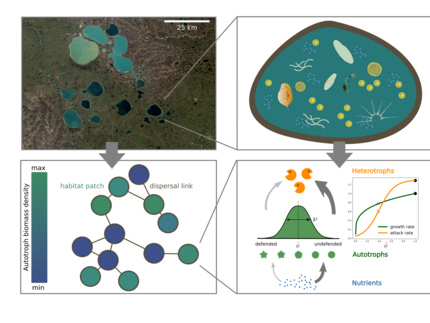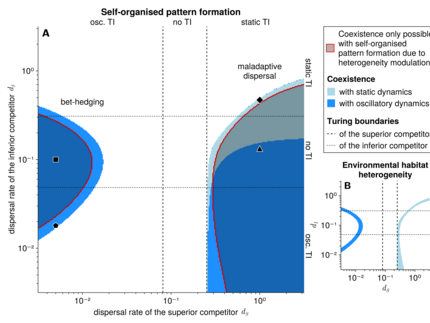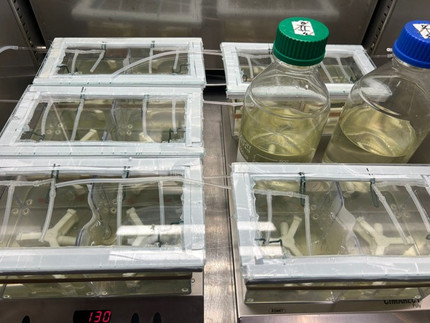Self-organised pattern formation in metacommunities
Contact persons: PD Dr. Christian Guill, Dr. Toni Klauschies
1. Maintenance of functional diversity by self-organised pattern formation
Using a small model food web oriented at phyto- and zooplankton communities in lakes we investigate how locally different selection pressures and source-sink dynamics created by self-organised pattern formation affect the maintenance of functional diversity of the phytoplankton within and among local communities. Harnessing the power of modern trait-based approaches, diversity within the phytoplankton communities is described by a continuous distribution of a functional trait that affects the defence against zooplankton grazers and trades off with the maximum growth rate or the ability to take up nutrients at low concentrations. We are interested in the effect of drivers on multiple organisational levels, from the size and complexity of the patch network over the diversity of the zooplankton predators to the shape of the trade-off between defence and growth rate in the phytoplankton community. The topic thus combines metacommunity ecology, trait-based ecology, and eco-evolutionary dynamics.
2. Eco-evolutionary dynamics in metacommunities
We have recently shown that emergent habitat heterogeneity due to self-organised pattern formation allows consumers with a single shared resource to coexist in metacommunities where an equivalent amount of externally determined habitat heterogeneity would not [link to study]. This is based on a feedback loop between competing species that differ in their abilities to induce pattern formation and to benefit from it. It also implies that dispersal-related traits (like maximum dispersal rate or sensitivity to dispersal-inducing cues) are under evolutionary selection, which can in the long term affect the ability of a community to exhibit pattern formation. First results indicate that dispersal traits tend to evolve such that the emergent patterns weaken or pattern formation is prevented altogether. However, this depends on the size and complexity of both the patch network and the local communities, as also sudden switches between qualitatively different patterned states are possible. Thus, general conditions under which self-organised pattern formation consistently occurs under the evolution of dispersal traits of the relevant species are not well established.
3. Experimental verification of self-organised pattern formation in planktonic metacommunities
Self-organised pattern formation is known from a variety of ecosystems, like mussel beds, benthic diatoms, dryland vegetation, or subarctic shrubs and trees (Rietkerk and van de Koppel, Trends Ecol. Evol. 2008). These systems have in common that space itself is continuous and roughly homogeneous, which leads to very conspicuous patterns in the form of spots, stripes, or labyrinth shapes. In network-organised systems like metacommunities, where the habitable space itself consists of discrete patches, self-organised pattern formation has been theoretically predicted, but because the emergent patterns are far less conspicuous, empirical or experimental evidence is rare. We develop experimental metacommunities consisting of different algae and zooplankton species (e.g. rotifers) with continuous or semi-continuous nutrient turnover. A technical challenge is to manipulate the connections between the habitat patches such that the diffusion- or dispersal rates of nutrients, algae, and rotifers are sufficiently different from each other, as this is a prerequisite of pattern formation.



